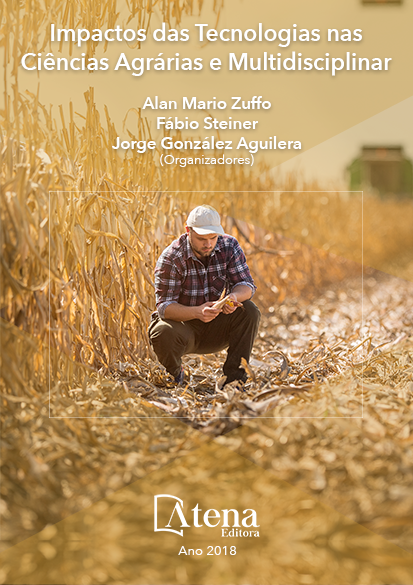
CARACTERÍSTICAS MORFOLÓGICAS DE PLANTAS E COMPONENTES DE RENDIMENTO DE MILHO SAFRINHA EM FUNÇÃO DE NÍVEIS DE NITROGÊNIO
O milho é muito exigente em
nutrientes, sendo o nitrogênio (N) o nutriente
requerido em maior quantidade pela cultura.
O objetivo do estudo foi avaliar o efeito de
níveis de adubação nitrogenada, aplicados em
cobertura, na cultura do milho. O trabalho foi
desenvolvido no município de Dois Vizinhos,
sudoeste do estado do Paraná. O experimento
foi conduzido em delineamento de blocos ao
acaso com quatro repetições e quatro níveis
de adubação nitrogenadas (0, 50, 100 e 150
Kg ha-1 N). Utilizou-se no estudo o híbrido
2B587Hx, o qual foi semeado em 15 de janeiro
de 2015 com densidade de 65.000 plantas ha-1
e espaçamento de 45 cm entrelinhas. Ao final
do ciclo da cultura avaliou-se: estande final
de plantas, diâmetro basal do colmo, altura
de inserção da espiga, altura final de plantas,
número de fileira por espiga, número de grãos
por fileira, número de grãos por espiga, umidade
do grão, massa de mil grãos e produtividade.
A utilização de 100 Kg ha-1 de N, resultou em maior número de fileiras por espiga
(16,8), contra 16,1 e 16,2 fileiras por espiga nos tratamentos com 0 e 150 Kg ha-1,
respectivamente. Observou-se que no tratamento com 100 Kg ha-1 de N, o número de
grãos por espiga de 559, diferiu estatisticamente do tratamento sem utilização de N,
com valores de 482 grãos por espigas. Não foi observado diferenças para as demais
variáveis avaliadas. A fertilidade do solo da área experimental, pode ter mascarado o
efeito dos níveis de nitrogênio avaliados.
CARACTERÍSTICAS MORFOLÓGICAS DE PLANTAS E COMPONENTES DE RENDIMENTO DE MILHO SAFRINHA EM FUNÇÃO DE NÍVEIS DE NITROGÊNIO
-
DOI: Atena
-
Palavras-chave: Zea mays, segunda safra, produtividade
-
Keywords: Zea mays, second crop, productivity
-
Abstract:
The corn is very demanding in nutrients, being the nitrogen (N) the
required nutrient in greater quantity by the culture. The objective of the study was to
evaluate the effect of levels of nitrogen fertilization, applied in cover, on corn crop.
The work was developed in the municipality of Dois Vizinhos, southwest of the state
of Paraná. The experiment was conducted in a randomized complete block design
with four replicates and four nitrogen fertilization levels (0, 50, 100 and 150 Kg ha-1 N).
Hybrid 2B587Hx was used in the study, which was sown on January 15, 2015 with a
density of 65,000 ha-1 plants and 45 cm spacing between the lines. At the end of the
crop cycle, the final stand of plants, basal stem diameter, ear insertion height, final
plant height, row number per spike, number of grains per row, number of grains per
spike, humidity of the grain, a thousand grain mass and productivity. The use of 100 Kg
ha-1 of N resulted in a higher number of rows per ear (16.8), compared to 16.1 rows and
16.2 rows per ear in treatments with 0 and 150 Kg ha-1, respectively. It was observed
that in the treatment with 100 Kg ha-1 of N, the number of grains per spike of 559,
differed statistically from the treatment without using N, with values of 482 grains per
spike. No differences were observed for the other variables evaluated. The soil fertility
of the experimental area may have masked the effect of the nitrogen levels evaluated.
-
Número de páginas: 15
- Vanderson


